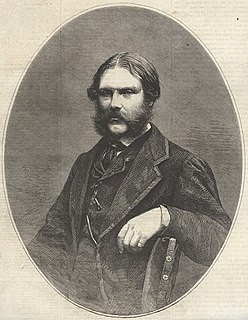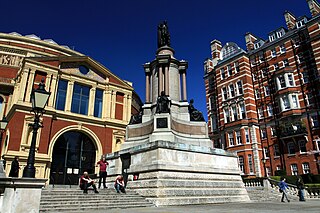
The Great Exhibition of the Works of Industry of All Nations, also known as the Great Exhibition or the Crystal Palace Exhibition, was an international exhibition which took place in Hyde Park, London, from 1 May to 15 October 1851. It was the first in a series of World's Fairs, exhibitions of culture and industry that became popular in the 19th century. The Great Exhibition was organised by Henry Cole and by Prince Albert, husband of the reigning monarch of the United Kingdom, Queen Victoria.

The Albert Memorial, directly north of the Royal Albert Hall in Kensington Gardens, London, was commissioned by Queen Victoria in memory of her beloved husband Prince Albert, who died in 1861. Designed by Sir George Gilbert Scott in the Gothic Revival style, it takes the form of an ornate canopy or pavilion 176 feet (54 m) tall, in the style of a Gothic ciborium over the high altar of a church, sheltering a statue of the prince facing south. It took over ten years to complete, the £120,000 cost met by public subscription.

Barnstaple is a river-port town in North Devon, England, at the lowest crossing point of the River Taw flowing into the Bristol Channel. From the 14th century, it was licensed to export wool. Great wealth ensued. Later it imported Irish wool, but its harbour silted up and other industries developed, such as shipbuilding, foundries and sawmills. A Victorian market building survives, with a high glass and timber roof on iron columns. The parish had a population of 24,033 at the 2011 census, and the built-up area of 32,411 in 2018. The town area with nearby settlements such as Bishop's Tawton, Fremington and Landkey, had a 2020 population of 46,619.

Swanage is a coastal town and civil parish in the south east of Dorset, England. It is at the eastern end of the Isle of Purbeck and one of its two towns, approximately 6+1⁄4 miles (10 km) south of Poole and 25 miles (40 km) east of Dorchester. In the 2011 census the civil parish had a population of 9,601. Nearby are Ballard Down and Old Harry Rocks, with Studland Bay and Poole Harbour to the north. Within the parish are Durlston Bay and Durlston Country Park to the south of the town. The parish also includes the areas of Herston, just to the west of the town, and Durlston, just to the south.

Albertopolis is the nickname given to the area centred on Exhibition Road in London, named after Prince Albert, consort of Queen Victoria. It contains many educational and cultural sites. It is in South Kensington, split between the Royal Borough of Kensington and Chelsea and the City of Westminster, and the area bordered by Cromwell Road to the south and Kensington Road to the north.

Sir Aston Webb was an English architect who designed the principal facade of Buckingham Palace and the main building of the Victoria and Albert Museum, among other major works around England, many of them in partnership with Ingress Bell. He was President of the Royal Academy from 1919 to 1924, and the founding Chairman of the London Society.

Albert Square is a public square in the centre of Manchester, England. It is dominated by its largest building, the Grade I listed Manchester Town Hall, a Victorian Gothic building by Alfred Waterhouse. Other smaller buildings from the same period surround it, many of which are listed.

Thomas Worthington was a 19th-century English architect, particularly associated with public buildings in and around Manchester. Worthington's preferred style was the Gothic Revival.

The Albert Memorial Clock is a clock tower situated at Queen's Square in Belfast, Northern Ireland. It was completed in 1869 and is one of the best known landmarks of Belfast.

Francis Fowke was an Irish engineer and architect, and a Captain in the Corps of Royal Engineers. Most of his architectural work was executed in the Renaissance style, although he made use of relatively new technologies to create iron framed buildings, with large open galleries and spaces.

Matthew Noble was a leading British portrait sculptor. Carver of numerous monumental figures and busts including work memorializing Victorian era royalty and statesmen displayed in locations such as Westminster Abbey, St. Paul's Cathedral and in Parliament Square, London.
Events from the year 1870 in Ireland.
Events from the year 1865 in Ireland.

The buildings and structures of Belfast, Northern Ireland comprise many styles of architecture ranging from Edwardian through to state-of-the-art modern buildings like the Waterfront Hall. The city's beautiful Edwardian buildings are notable for their display of a large number of sculptures. Many of Belfast's Victorian landmarks, including the main Lanyon Building at Queens University in 1849, were designed by Sir Charles Lanyon.

William Joseph Barre was a prolific Irish architect who built many well known buildings in Belfast in a Gothic Revival style, but was always overshadowed by his great rival, Charles Lanyon.

Edward Bowring Stephens, was a British sculptor from Devon. He was honorary secretary of the Institute of Sculptors circa 1861.

The Memorial to the Great Exhibition is an outdoor monument commemorating the Great Exhibition (1851) and depicting Albert, Prince Consort, designed by Joseph Durham with modifications by Sydney Smirke and located south of Royal Albert Hall in London, United Kingdom. Originally installed in the Royal Horticultural Society gardens in 1863, it was relocated to its current site during 1891–1893 when the gardens were reconstructed and Prince Consort Road was created.

The Albert Clock is a clocktower memorial in Barnstaple in Devon to Albert, Prince Consort, the husband of Queen Victoria. It has been listed Grade II on the National Heritage List for England since 1988.
The Prince Albert Memorial is a memorial in Swanage, Dorset in the form of a stone obelisk to Prince Albert, the consort of Queen Victoria, who died in 1861. The memorial was erected in 1862, and is notable for having been the earliest civic memorial to the Prince. It was dismantled in 1971, and only rebuilt 50 years later, in 2021.















